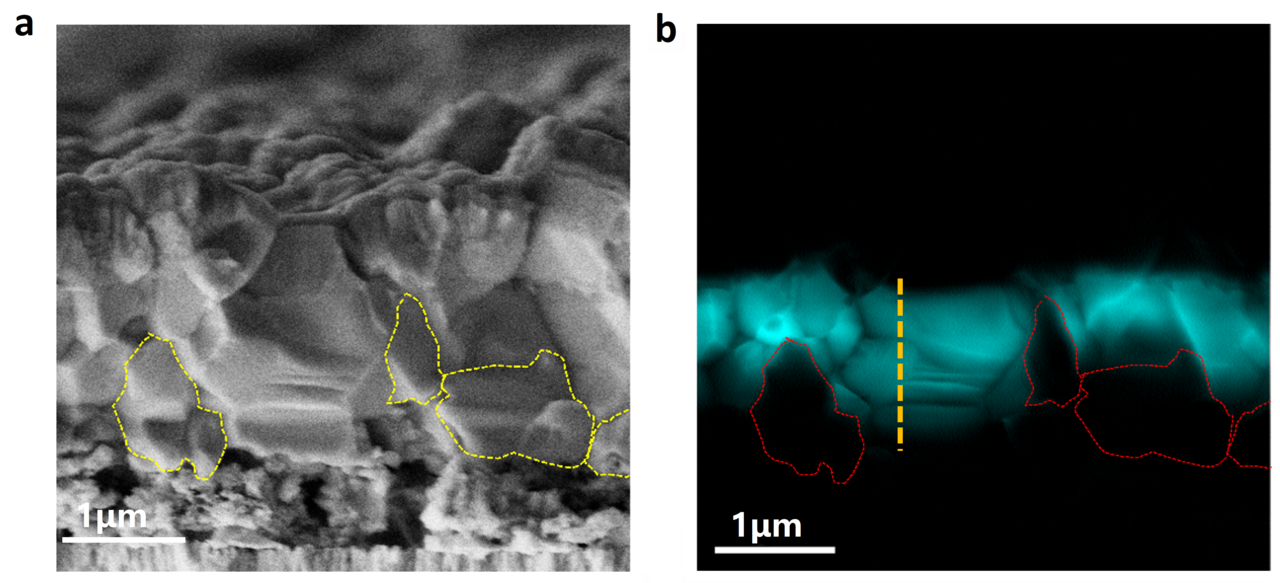Kesterite Cu2ZnSn(S,Se)4 is a promising green photovoltaic material, with cheap earth-abundant and environmentally benign raw materials, stable structure, and excellent optoelectronic properties, except that the power conversion efficiency of kesterite solar cells is still yet to reach the commercialization-viable level. The research community has encountered a grand challenge in improving the performance of kesterite solar cells which is associated with the unprecedented complexity of the material system as well as the carrier loss mechanisms. It has been a long debate as to which carrier loss mechanism is dominating in current state-of-the-art kesterite solar cells. For solar cells, essential progress can be hardly made if the dominant carrier loss mechanism remains unclear.
In 2020, we reported the 12.5% record efficiency for Cu2ZnSnSe4 (CZTSe) solar cells (https://onlinelibrary.wiley.com/doi/abs/10.1002/adma.202005268). The record efficiency is achieved through the control of bulk defects by engineering the local chemical environment during the formation of CZTSe. After that, we were trying to figure out what is the main energy loss mechanisms in these over 12% efficient CZTSe solar cells, especially the current loss mechanisms other than the optical loss? The carrier transport mechanisms were carefully checked, by employing a set of complementary characterizations like temperature-dependent current-voltage measurement and electron-beam induced current (EBIC). Particularly, the EBIC data shows no carrier collection within the CZTSe grains that are not directly connected to the junction interface (Figure 1). According to the reported large band bending at the CZTSSe grain boundaries as observed from surface Kalvin Probe Force Microscopy (KPFM) measurement, we attribute this phenomenon to the barrier caused by band bending. Then the manuscript was submitted to ACS Energy Letter. The reviewers’ feedback was not very negative. However, the manuscript was rejected possibly because there were too many major issues raised. One of the reviewers (thanks to him/her) pointed out that the grains with low EBIC intensity should be attributed to the recombination inside the grains. Although no evidence/argument was provided, that comment raised an important question: what is the exact reason for the weak EBIC signal of the grains disconnected to the junction? Is this caused by the recombination inside these grains, the recombination at the grain boundaries, or just the large barrier at grain boundaries?

Figure 1. Scanning electron microscopy (SEM) and electron beam induced current (EBIC) image of a cross-section of the CZTSe solar cell . (Credit: UNSW)
To answer these questions, the most straightforward way is by applying cathodoluminescence (CL) mapping on these grains. Fortunately, the UNSW EMU centre was just about to commission a CL system which happened to have near-infrared detectors (thanks to the great effort led by our authors, Prof Richard Tilley, A/Prof Ziv Hameiri and Prof Xiaojing Hao). After a period of trouble shooting by Dr Karen Privat and Dr Jialiang Huang, we got clear CL mapping images on our CZTSe solar cells. It is clear that the bottom grains are as bright as the top ones in the CL image, and the grain boundaries are much darker compared to the grain interiors (Figure 2.). Apparently, grain boundary recombination is dominating the carrier loss that we observed from EBIC images. What an exciting, suppressing, yet reasonable result!

And then more questions came out: what is the grain boundary recombination velocity? To what extent the grain boundary recombination reduces the effective minority carrier lifetime and the device performance? What is the difference between the carrier mobilities and carrier lifetimes we measured from the films and the exact values inside the grains? To answer these questions, more exciting and challenging tasks were taken: cross-sectional KPFM measurement to determine the band bending at grain boundaries, three-dimensional device simulations to determine the carrier mobilities and carrier lifetimes inside the grains. With the contribution from the reviewers invited by Nature Energy, the radiative recombination due to bandgap/potential fluctuation is also included for consideration. Moreover, a clear pathway toward 20% efficiency CZTSe is identified, which is mostly related to suppressing the grain boundary recombination. Eventually, we established a micro-to-macro linked framework that can analyse the microscopic carrier loss mechanisms in emerging polycrystalline thin-film solar cells, which is not limited to kesterite, can be antimony chalcogenides, perovskite, and other more in principle. This framework is also inspired by Krause’s paper for CIGS solar cells (https://doi.org/10.1038/s41467-020-17507-8).
As we can see, we are guided by good questions along this exciting journey, as we are strongly supported by our collaborators and co-authors, including but not limited to the characterization support from Mark Wainwright Analytical Centre (MWAC) at UNSW Sydney (Karen Privat, Yin Yao, Richard Webster, Soshan Cheong, Richard Tilley) and Institute of Physics, Chinese Academy of Sciences (Prof. Hui Li), lab access provided by Jinan University (Prof. Yaohua Mai) during our lab shut-down period, constructive discussion and comments from Prof. Thomas Unold (HZB), and Prof. Chunsheng Jiang from NREL, as well as the contributions from the reviewers and the editors.
So, what’s next? Until now, we have realized that we actually know little about the grain boundaries of kesterite materials: What are the possible chemical structures the grain boundaries may have? What kind of trap states and recombination centres the grain boundaries can have? Can they be effectively passivated to the extent that comparable to the mature commercialised CIGS and CdTe solar cells? Always get more questions to answer! So, the journey toward high-efficiency, green, cheap, and stable thin-film photovoltaic technology will continue, and we hope we can get more partners to join this amazing discovery journey!






Please sign in or register for FREE
If you are a registered user on Research Communities by Springer Nature, please sign in